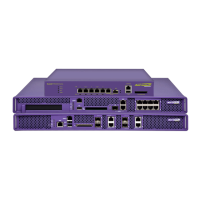Summit WM3000 Series Controller System Reference Guide 121
hotspot access controller forces this un-authenticated user to a Welcome page from the hotspot Operator
that allows the user to login with a username and password. This form of IP-Redirection requires no
special software on the client.
To configure a hotspot, create a WLAN ESSID and select Hotspot as the authentication scheme from the
WLAN Authentication menu. This is simply another way to authenticate a WLAN user, as it would be
impractical to authenticate visitors using 802.1x authentications. Having enabled a hotspot, you will
need to configure it. There are 2 parts to the hotspot configuration process:
● Setting up the Hotspot Web pages
● Setting up the Radius server.
Controller Hotspot Redirection. The controller uses destination network address translation to redirect
user traffic from a default home page to the login page. Specifically, when the controller receives an
HTTP Web page request from the user (when the client first launches its browser after connecting to the
WLAN), a protocol stack on the controller intercepts the request and sends back an HTTP response after
modifying the network and port address in the packet (thereby acting like a proxy between the User
and the Web site they are trying to access).
To configure hotspot support:
1 Select Network > Wireless LANs from the main menu tree.
2 Select an existing WLAN from those displayed within the Configuration tab and click the Edit button.
A WLAN screen displays with the WLAN’s existing configuration. Refer to the Authentication and
Encryption columns to assess the WLAN’s existing security configuration.
3 Select the Hotspot button from within the Authentication field. The Radius Config... button on the
bottom of the screen becomes enabled. Ensure a primary and optional secondary Radius Server have
been configured to authenticate users requesting access to the hotspot supported WLAN. For more
information, see “Configuring External Radius Server Support” on page 133.
4 Click the Config button to the right of the Hotspot checkbox.
A Hotspot screen displays, allowing the user to define one of three available hotspot types.
5 Use the drop-down menu at the top of the screen to define whether this WLAN’s Web pages are:
● Internal - three HTML pages with basic functionality are made available on the controller's
internal HTTP server. The HTML pages are pre-created to collect login credentials through
Login.htm, send them to a Radius server and display a Welcome.htm or a Faliure.htm depending
on the result of the authentication attempt. For more information, see “Configuring an Internal
Hotspot” on page 122.
● External - a customer may wish to host their own external Web server using advanced Web
content (using XML, Flash). Use the External option to point the controller to an external hotspot.
For more information, see “Configuring an External Hotspot” on page 125.
● Advanced - a customer may wish to use advanced Web content (XML, Flash) but might not have
(or would not want to use) an external Web server, choosing instead to host the Web pages on the
controller's HTTP Web server. Selecting the Advanced option allows for the importing the Web
pages from an external source (like an FTP server) and hosting them on the controller. For more
information, see “Configuring an Advanced Hotspot” on page 127.
The appearance of the Hotspot screen differs depending on which option is selected from the drop-down menu. You
may want to research the options available before deciding which hotspot option to select.

